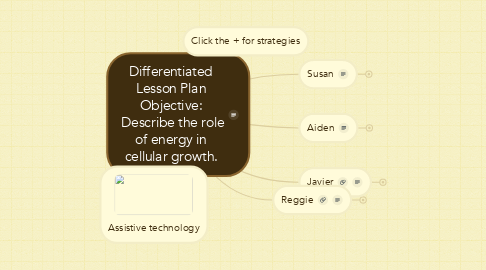Differentiated Lesson Plan Objective: Describe the role of energy in cellular growth.
by Diane Mahoney

1. Assistive technology
2. Susan
2.1. • Strategies: Eliminate extraneous noise. turn off equipment that creates background noises, such as fans and projectors, when not in use. Look directly at the student and face him or her when communicating or teaching. • Say the student’s name or signal their attention in some way before speaking. • Assign the student a desk near the front of the classroom, or where you plan to deliver most of your lectures. Speak naturally and clearly. Use facial expressions, gestures and body language to help convey the message, but don't overdo it. Writing all homework assignments, class instructions and procedural changes on the board. Allow them to use a laptop for notes and communication during class. Establish a procedure for emergencies, such as writing the word fire on the board. Provide students with an outline of the daily lesson and printed copies of the notes. Utilize visual aids with captionin. Use posters, charts, flash cards, pictures, manipulatives, graphic organizers, artifacts or any visual items to illustrate concepts. Use captioned videos in class. Follow the IEP as closely as possible. Monitor student progress in daily work and assignments. Ask the student for feedback regarding her understanding or areas where she might be confused. Maintain close contact with parents and other teachers. Arrange desks in a circular pattern if possible so hearing impaired students can see other students. Remind this student that she is expected to be a high achiever as expected for all students in the class and that she can be as successful as Peter Townsend the guitarist, Thomas Edison and John Dickinson, AIA, a hearing impaired architect who designs education facilities for students with hearing impairments.
3. Aiden
3.1. Strategies: Have him sit closer to the front but to one side of the class and give him opportunities to move. This will help Aiden focus on direct instruction and visuals. Aiden could be assigned to be the runner for class and given single and simple commands to bring demonstration materials to the front of the class. Allow him to complete homework in a lab notebook so he can keep track of it better. Give him time to think about a question and his answer before requiring him to answer a question in class. Perform formative assessments often and offer help without his having to ask. If he is observed behaving in inappropriate ways, please talk with him in private. Give detailed written explanations of expectations for activities, homework, tests and projects
4. Javier
4.1. use cooperative learning and other group techniques to build a sense of community. • Focus on providing biology terms in English to Javier so he can learn to speak like a scientist. Help Javier understand the meaning of words that have multiple meanings but in the science context. • Build on his prior knowledge to help him catch up in areas he may have missed earlier in school. • Use verbal repetition, slower speech and write down terms and visually display or demonstrate the meaning of the term. Provide videos for homework so he can pause and replay them and practice saying words out loud.
5. Reggie
5.1. • Strategies: Provide a quiet area for activities like reading, answering comprehension questions. Use books on tape. Use books with large print and big spaces between lines. Provide a copy of lecture notes. Don’t count spelling on tests. Allow alternative forms for science literature reports such as drawing a flowchart for how a cell uses energy. Allow the use of a laptop or other computer for in-class essays. Use multi-sensory teaching methods. Teach Reggie to use logic rather than rote memory. Present material in small packets such as threes general uses of energy in a cell, chemical work, transport work and mechanical work. Allow students to use reading technology such as reading pens or text to speech books (21st Century Strategy).
6. Click the + for strategies


